Incoming freshmen have been excluded from these previews, as we'd like to wait and see what they have to offer on the NCAA level before we come to any long-term conclusions.
-Top NBA Draft Prospects in the Big Ten, Part One
-(#1) Cody Zeller Video Scouting Report
-Top NBA Draft Prospects in the Big Ten, Part Two
(#2) Trey Burke
(#3) DeShaun Thomas
(#4) Aaron Craft
(#5) Branden Dawson
#6 Trevor Mbakwe, 6-8 ½, Sixth Year Senior, PF/C, Minnesota
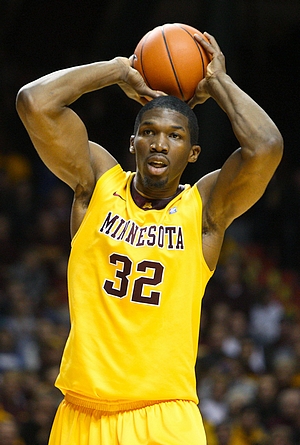
Matt Williams
When we last checked in our Trevor Mbakwe in January of 2011, he was averaging a double-double and in the midst of a breakout junior season that could accurately be characterized as his first full season at the Division 1 level. As we outlined in our last report, Mbakwe's career to that point had been tumultuous to say the least, marked by a miraculous recovery from preseason knee surgery during his 11 game freshman campaign under Tom Crean, a transfer from Marquette, an assault charge stemming from his time at Miami Dade Junior College, and ultimately, two full seasons without appearing in NCAA games.
The last year and a half has offered some solace on the legal front for the Minnesota native. Despite violating the terms of a restraining order just days after we wrote about him, he finally pled no contest to the assault charges in January, effectively putting an end to the case that had loomed large for nearly three years.
Amidst the challenges he faced off the court, Mbakwe managed to build a strong resume coming into his redshirt senior season. Suffering a torn ACL just seven games into the 2011-2012 campaign, Mbakwe was granted a rare sixth of eligibility. Recently returning to practice, the 23 year old (turning 24 in January) will look to be the leader many expected him to be for the Golden Gophers a season ago as he begins to rebuild his draft stock after playing just 49 official games in the past five years.
Where Mbakwe appears to be physically will have a lot to do with how he's perceived by the end of the year. An undersized power forward cut from the same mold as Morehead State product Kenneth Faried, Mbakwe stands 6'8 with a 7'4 wingspan. He was not as quick off the ground or quite as relentless as the Nuggets bruiser, but Mbakwe was a similarly effortless athlete with a penchant for rebounding out of his area and finishing emphatically above the rim before his injury. Mbakwe will need return to the form that made him one of the top per-40 minute pace-adjusted rebounders in our database if he is to reclaim the buzz he had generated among NBA scouts.
Mbakwe's rebounding and energy are the keys to his value at the NBA level at this juncture. A capable finisher thanks to his length and athleticism, Mbakwe is otherwise a mixed bag offensively. He was shooting a super-efficient 60.4% before his injury last season, and has proven to be a capable scorer at the college level, but is a limited shooter and unrefined back-to-the-basket scorer. He shows some promise in both areas, having improved the mechanics of his shot at the foul line and dropping in a deft jump hook on occasion. Despite seeing most of his touches in the post, but otherwise earning his points by playing with tenacity on the offensive glass and ducking in for catch-and-finish opportunities, Mbakwe's skill set seems to align itself well with the type of hustle-based role he'd likely be asked to play at the next level, but continued development as a shooter or one-on-one threat would add a dimension to his game.
Defensively, Mbakwe makes an impact with his length and leaping ability, but is still figuring out how to be a consistent presence on this end of the floor. He shows good quickness on the perimeter and has solid strength for his size defending the post, but looks most impressive when making the occasional highlight reel block or pulling down a rebound in traffic by virtue of his athleticism and length. The power forward struggles with bigger players who make it a point to pin him in the post and is still prone to his share of mental lapses. Making the most of his tools defensively and finding ways to better compensate for his lack of great bulk inside would help Mbakwe take his game to the next level on that end of the floor.
An undersized but athletic big man always has a place in an NBA rotation if he can rebound and defend at an elite level. Prior to his injury, Mbakwe seemed to have at least half of that equation figured out. His age is obviously a concern, as he'll be 24 years old at the time of the draft, but his health is a bigger factor. Teams will do their homework on Mbakwe's health and off-the-court incidents, but he's certainly a name to keep an eye on if he is the same prospect he was a season ago, as players with his motor and physical tools are always extremely coveted.
#7 Adreian Payne, 6-10, Junior, PF/C, Michigan State
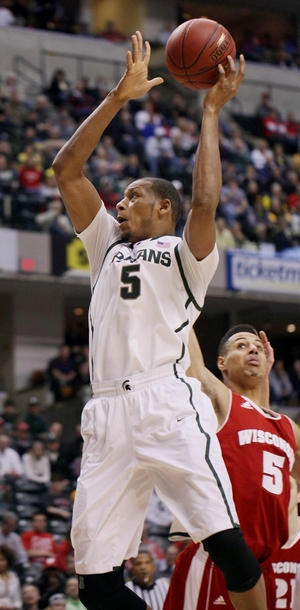
Joe Treutlein
Following a largely unproductive freshman campaign, top-30 high school recruit Adreian Payne took some very strong steps forward as a sophomore, improving notably in nearly every facet of his game. Heading into his junior season, Payne is primed for another strong year, and will have every opportunity to expand his role with Draymond Green graduating and leaving 33 minutes per game for the taking.
Looking at Payne's sophomore showing, the first thing that stands out is his improved physique, as he's gone from a 215-lb high school senior to a solidly filled out 242 pounds as of this summer. Coach Tom Izzo reportedly wants to eventually see him in the 245-250 range, and Payne certainly appears to have the frame to handle the extra weight.
On the court, Payne saw a strong increase in minutes, production, and efficiency, making good use of his improved frame and showing much more confidence in finding ways to consistently impact the game.
Payne's offensive contributions come predominantly within five feet of the basket, where he's developed a penchant for throwing down some ferocious highlight reel dunks. In addition to his excellent size, length, and athleticism, Payne has developed some nice hands and coordination that make him a very dangerous threat on pick-and-rolls, especially in combination with his confidence finishing with power at the rim.
Payne is similarly explosive attacking the offensive glass, where he shows good instincts and pursuit, along with a nice second bounce and of course, no qualms about finishing strong. His ability finishing on off-ball cuts lags behind his pick-and-roll and offensive rebounding somewhat, as he's still coming into his own with his overall feel for the game, but he's not someone defenses want to leave alone roaming around the paint.
In terms of his post-game, Payne has improved some from his freshman year, still showing largely crude footwork and having problems with turnovers against top competition, but doing a better job taking advantage of his physical tools and showing decent touch on his finesse moves. He's much more comfortable executing moves against weaker competition and with more space to operate, seeing his effectiveness go down markedly in more difficult situations. This area is still a work in progress for him, but he shows some nice flashes, specifically with a running hook that shows a very high release point and solid touch.
Payne's skill level in general is still below average for a junior big man with NBA potential, but he showed a considerable learning curve over the past two years, most notably with his much improved shooting. His FT% went from a dismal 48.6% on one attempt per game to a respectable 69.7% on 2.4 attempts per game, and he also showed flashes of turnaround jumpers in the post and even some 10-15 footers later in the season. While his in-game shot isn't NBA-ready by a long shot, he shows solid mechanics and appears to be putting in the work, making it something to watch out for this season.
Defensively, Payne has also taken some strong steps forward, developing into a pretty effective post defender who does a good job taking advantage of his physical tools. While his fundamentals are still a little rough around the edges and he's prone to being overpowered against players who are in his league physically, he does a good job moving his feet and using his length to contest shots, being tough to score on for most opponents. He focused less on blocking shots this season, but still is a worthy threat there with his length and mobility. Things are less encouraging for Payne at this stage on the perimeter, where he looks mostly lost in pick-and-roll defense despite having considerable potential down the road with his elite physical tools.
The biggest concern for Payne heading into this season is if he steps up to fill the voided role in Michigan State's frontcourt and if his body can handle a significant increase in minutes from the 17.9 per game he saw as a sophomore. Payne reportedly has smaller lungs than an average person his size would, resulting in reduced lung capacity that makes it difficult to play extended minutes. That Payne has overcome this and made such a marked improvement as a sophomore is a testament to his work ethic, and it will be interesting to see if he can make similar gains as a junior. Payne already brings an intriguing package to the table with his physical tools, offensive rebounding, ability to finish around the basket, and defensive potential, so he could certainly put himself firmly on the NBA radar if he makes additional strides this year.
#8, Brandon Paul, 6'4, Senior, Shooting Guard, Illinois
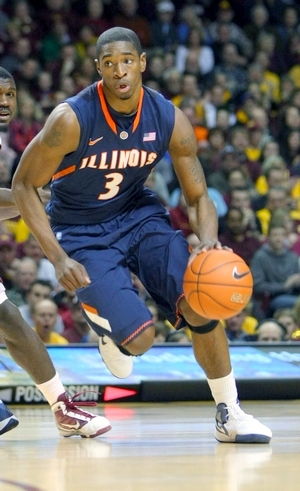
Derek Bodner
After an up and down junior season that saw the Illini struggle to a 6-12 Big 10 conference record, Brandon Paul will try to show enough improvement and consistency under new coach John Groce to solidify himself as an NBA prospect.
Showing average size for the shooting guard position at 6'4", Paul somewhat makes up for this with long arms, strong frame and excellent athleticism. He's an extremely fluid guard who can create his own shot at will and play above the rim. That being said, Paul suffered a broken jaw playing pickup basketball over the offseason and reportedly lost 15 pounds while his jaw was wired shut. He began working out again in August and reportedly has added most of that weight back, but exactly what kind of shape he comes in at will be interesting to watch.
When we last looked at him after his freshman season, Paul's 33.3% field goal percentage ranked dead last in our database. His efficiency has improved from 44% true shooting percentage to 52% -- but that is still among the bottom third of shooting guard prospects in our database. He's still yet to shoot over 39% from the field in any of his three seasons at Illinois.
While showing terrific flashes of versatility as an all-around scorer, Paul remains largely a perimeter gunner, with over two thirds of his attempts coming from jump shots, according to Synergy Sports Technology. Nearly half of his attempts came from three point range, where he shot a fairly pedestrian 33.3%. His overall form can look solid, with good elevation and a high release point, but his mechanics can vary quite a bit from shot to shot, especially when defended. He has improved his catch and shoot efficiency quite a bit from the last time we looked at him, which bodes well for his success at the next level as that is a role he would likely be asked to fill, but his consistency in this facet of the game can still fluctuate greatly. It doesn't help him that the majority of his catch and shoot attempts come with a hand in his face, as Illinois lacked great shot creators.
When Paul first came onto the scene at Illinois he had virtually no mid-range game. While the majority of his jump shots still come from beyond the arc, his comfort level and efficiency from mid-range has improved, largely from his improvement shooting coming off of screens, another trend that, if it continues, would be a good boost to his draft stock and a role he could fill at the next level.
The other major change from when we profiled him after his freshman season has been his increased usage off pick and rolls, which has largely been a mixed bag to this point. While he's comfortable shooting off the dribble, his recognition and decision making place him in bad positions frequently, leading to a high turnover rate in this situations. Not blessed with the best court vision for a potential combo guard, Paul also has a bad habit of putting himself in bad positions coming off the screen, prone to picking up his dribble too early, getting trapped, and forcing bad passes. Overall his recognition leaves something to be desired as a decision maker, which is evident in both his shot selection and his increased turnover rate.
Off the dribble, Paul is a below average finisher at the rim. He is a very good athlete, but struggles finishing through contact and doesn't have much in the way of a left hand. When he does go left, his ball handling isn't advanced enough with his off hand to get to the rim with consistency, often times settling for pull up, contested mid-range jumpers. Paul needs to do a much better job of learning to create and finish through contact at the basket, as he's simply too strong and athletic to convert just 48% of his attempts at the rim like he did last season.
On the defensive side of the ball, Paul shows good ability to fight through screens and defend the pick and roll. He also moves his feet fairly well. He does have a tendency to lose his man off the ball a little too much, but overall shows good physical attributes and effort on this end of the court.
The wild card in his draft stock is the arrival of John Groce, who replaced Bruce Weber last spring after the Illini's disappointing 17-15 season. With Groce, the Illini could play a faster paced game, which could help Paul get more efficient looks at the basket.
With a solid senior season, Brandon Paul has more than enough talent to have a breakout year and force NBA teams to reevaluate him after underachieving consistently relative to his talent level for the past three years. Very few collegiate shooting guards display the same combination of strength, athleticism and shot-creating potential, but for whatever reason, he hasn't been able to produce efficiently outside of a few eye-opening performances.
Paul would do better on a team with good shot creators next to him, where he could get more open catch and shoot opportunities and shots off screens and be forced to create for himself less, but with an overall dearth of shot creators on the Illinois roster he is likely going to be asked to fill a larger role. How he's able to handle that will play a deciding factor in where his stock ends up at the end of the season.
#9 Keith Appling, 6-2, Junior, Point Guard, Michigan State
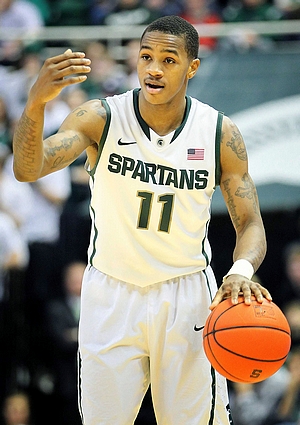
Jonathan Givony
After seeing his role for Michigan State's increase with the departure of Kalin Lucas between his freshman and sophomore seasons, Keith Appling will be expected to take on even more responsibilities as a junior now that half-court offensive facilitator Draymond Green is off to the pro ranks as well.
Showing a solid, but not overwhelming physical profile in terms of size, strength and athleticism, Appling is a role-playing guard who does what he's asked to offensively and is probably best known for his work on the defensive side of the ball.
Appling saw the biggest share of his offensive possessions come in transition situations last year, which is a solid indication of the role he played in Tom Izzo's disciplined offense. Seeing minutes at both guard spots, Appling typically brings the ball up the floor and then dumps it off to one of his teammates (usually Draymond Green) in the half-court, although he will sometimes get it back late in the shot-clock to create in pick and roll situations.
An unselfish guard with a team-first mentality, Appling does a very good job pushing the ball in the open court and finding teammates in drive and dish situations. In the half-court, Appling is still finding his way as a consistently effective shot-creator, especially in one on one situations, something that will be interesting to keep track of this season as his offensive responsibilities inevitably increase. He struggled with his decision making in the half-court at times last season, particularly under pressure, rendering him somewhat turnover prone.
Where Appling will have to improve the most is as an outside shooter, as he made just 28% of the 130 jumpers he attempted last season. Sporting, long, slow, deliberate shooting mechanics with both his feet set and off the dribble, opposing teams have no issues sagging off him and forcing him to beat them outside.
Appling's biggest calling card as a NBA prospect lies in his play on the defensive side of the ball. Although not incredibly big or strong, he's a tough, intense and extremely competitive guard, highly attentive and capable of putting excellent pressure on the ball. Michigan State was the third best defensive team in college basketball last season, and Appling played no small part in that.
Appling's development as an offensive player over the next two seasons will likely play a key role in how he's viewed from a NBA standpoint. If he can improve his outside shooting and show that he can be called upon to create offense reliably off the dribble, he'll be in good shape to carve out a career for himself at the professional level. He has all the makings of a very solid NBA backup point guard, provided he can continue to iron out the wrinkles in his offensive game.
#10 Christian Watford, 6'8, Power Forward, Senior, Indiana
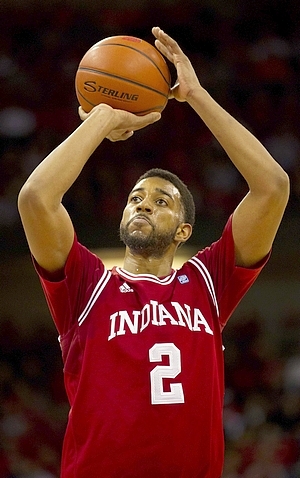
Kyle Nelson
After a breakthrough sophomore season, Christian Watford solidified his standing as a key component of Indiana's offense during the Hoosier's return to prominence, culminating in a 27-point performance in a Sweet 16 rematch with Kentucky. While Watford's role changed significantly between his freshman and sophomore seasons, his junior season and experience testing the NBA Draft waters gave scouts a better idea of what he can offer an NBA team.
Standing 6'8, with a wiry 229-pound frame and a long wingspan, Watford possesses average size and athleticism for the power forward position.
What sets Watford apart as a prospect, then, is his unique skill set for his size. Though his scoring output last season was hardly exceptional, he is an elite perimeter shooter who made 44% of his three-point attempts.
For the second consecutive season, Watford ranks favorably among NCAA big men last season as a perimeter shooter. While his mechanics are not perfect and he has a tendency to fade away from the basket, his size, length, and quick release make it very hard to contest his shot, as does his proficiency at knocking down shots off of the dribble. Furthermore, he is an excellent free throw shooter, which suggests that while his form is not perfect, it clearly works well for him.
For as efficient a scorer as he is from the perimeter, he regressed significantly from inside of the arc, shooting an abysmal 40.5% from 2-point range, which ranks as one of the lowest 2FG% ever logged by a power forward in our database. A brief look at Synergy's Play Type breakdowns reveals that Watford sees just 11.1% of his possessions in post-ups and 10.7% off cuts, with 14.6% possessions coming off of isolations; but this doesn't explain why one of the top shooters in the nation is so inefficient inside of the arc.
Outside of his perimeter shooting, Watford finds most of his inside opportunities by facing up and creating his own shot. While Watford can get from the perimeter to the basket in two of three dribbles and he does show intriguing potential as a shot creator at his size, he's very loose with the ball and his inability to dribble or finish with his left hand make his drives predictable and limits his versatility as a finisher. Furthermore, he does not seem to possess the touch or toughness to finish difficult shots around the basket, of which he attempts plenty.
Watford is not a prolific finisher with his back to the basket, either, as he lacks the sure hands and footwork to finish confidently after receiving the ball in the post. While he is quite mobile for a big man and can often get by his man with his quickness alone, he is very right-hand dominant and struggles even to post up on the left block let alone finish with his left hand. While freshman Cody Zeller's emergence as one of the nation's top centers certainly limited Watford's minutes and post touches, Synergy tells us that his proportion of post-up opportunities to total possessions and his low 2-point percentages are consistent with his sophomore numbers. Therefore, he still has a long way to go before being considered much of a post-scoring threat.
While Watford possesses NBA-ready perimeter shooting ability, his defense is a different story altogether. As was also the case during his sophomore season, Watford's average physical and athletic profile limits him as a defender at the collegiate level. As was particularly visible in his match-ups against Kentucky's NBA caliber frontcourt, Watford has decent lateral quickness, but still struggles at times to stay in front of perimeter oriented power forwards, let alone quicker guards and wings. Similarly, while his length still allows him to contest shots effectively both inside and outside, he still has trouble holding his own in the post. While he is not always focused and aggressive on defense, his lack of bulk and average toughness and will continue to be a significant problem moving forward.
Finally, Watford remains a below average rebounder for his size and position, posting a paltry 8.0 per 40 minutes pace adjusted and again ranking among the least productive power forward prospects in the NCAA in this area.
Going into his senior season, Watford has plenty of room for improvement to establish himself as a legit NBA player. While he is an elite shooter and versatile scorer who adapted well to a decreased role, he is not nearly a good enough defender, rebounder, or inside scorer to guarantee himself a spot in an NBA rotation.
Furthermore, while adding bulk and improving his conditioning is essential to his NBA prospects, he is still recovering from an off-season foot injury and will vie for minutes in an even deeper frontcourt rotation. Therefore, Watford still has quite a bit to prove to scouts while continuing to play an integral role for an emerging championship contender. He is an intriguing prospect regardless, but Christian Watford could move up draft boards if he makes the type of improvement as a senior that his potential suggests is possible.













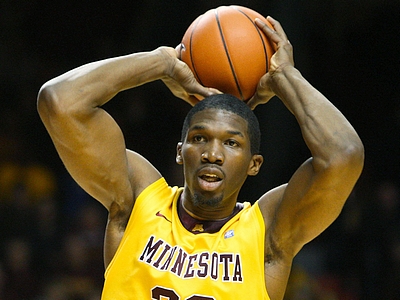



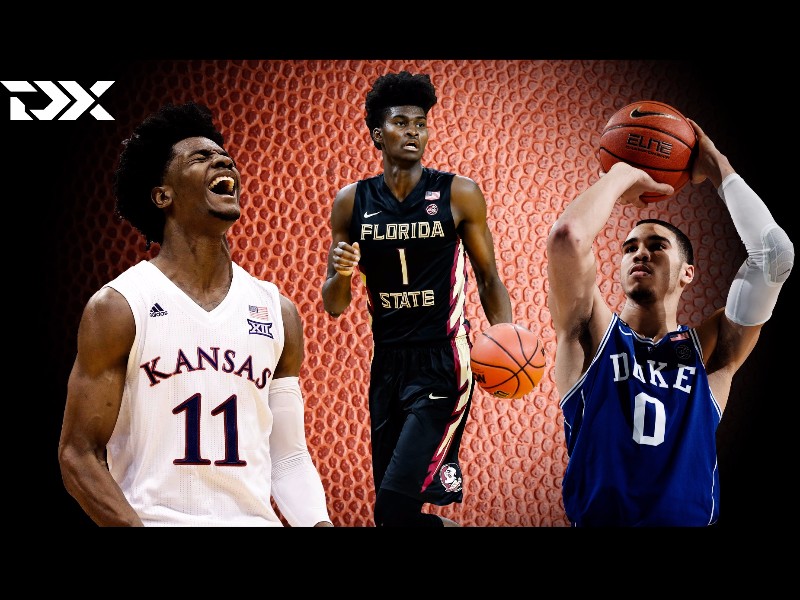
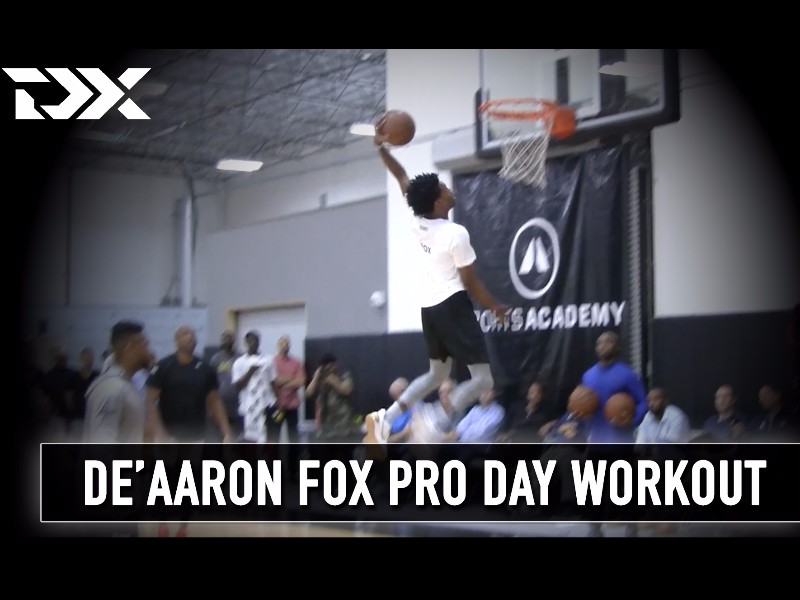


















Comments